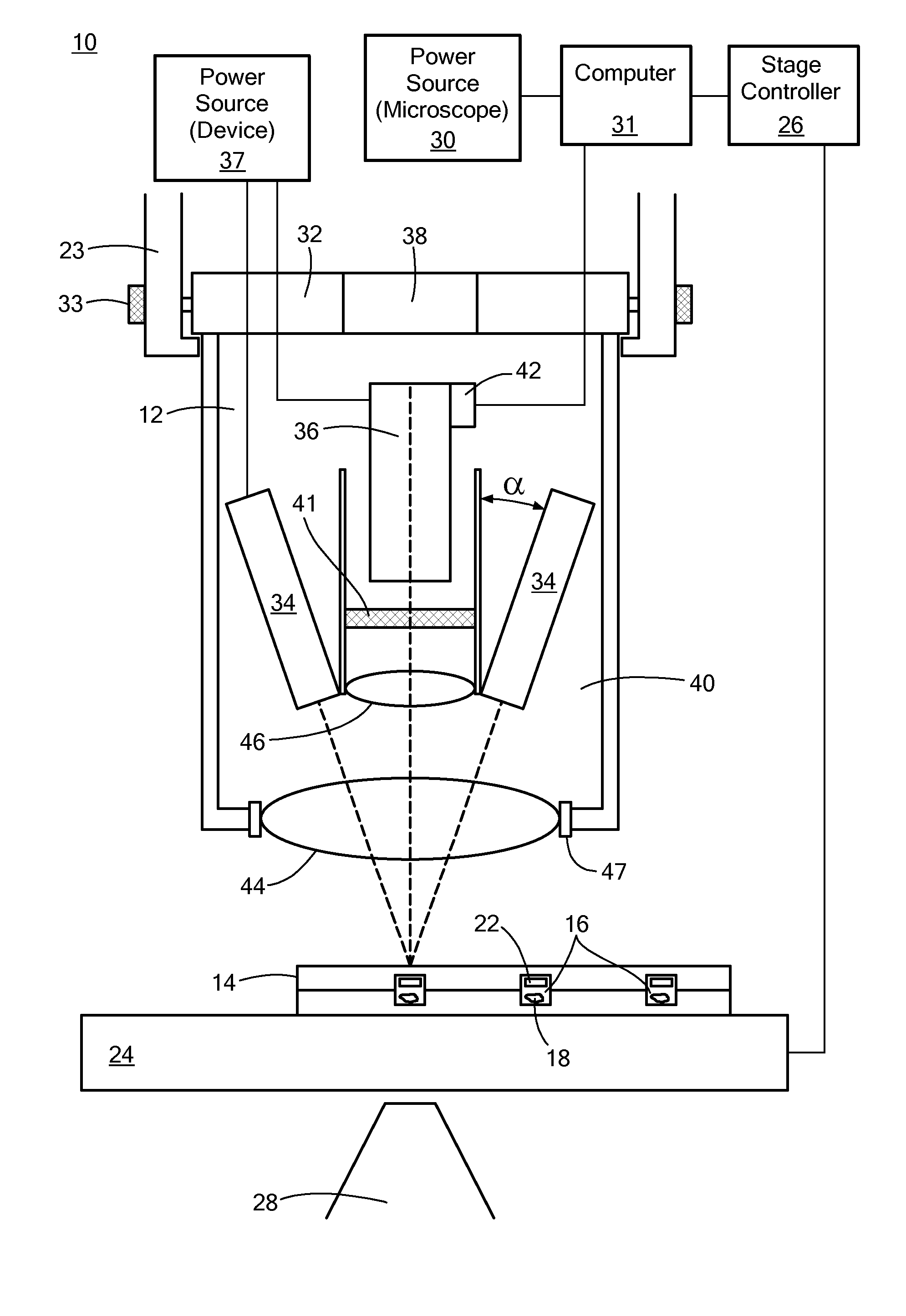Microscope accessory and microplate apparatus for measuring phosphorescence and cellular oxygen consumption
a microplate apparatus and accessory technology, applied in the field of microscopy, can solve the problems of contributing significantly to the cost of the system, not working well with very small wells, and not providing the necessary sensitivity to measure single-cell oxygen consumption
- Summary
- Abstract
- Description
- Claims
- Application Information
AI Technical Summary
Benefits of technology
Problems solved by technology
Method used
Image
Examples
first embodiment
[0023]Referring now to FIGS. 1A (front view) and 1B (side view), schematic representations of a system 10 and device 12 in accordance with the principles of the present invention are shown. The system 10 may generally include a phosphorescence measurement device 12, a sample holder 14 having a plurality of sample wells (or “microwells”) 16 in which one or more samples 18 may be contained, and an inverted microscope 20 for imaging the samples 18. The sample holder 14 may further include one or more sensors 22 for measuring oxygen levels, changes in pH, or other parameters.
[0024]The inverted microscope 20 may further include a condenser holder 23, a movable (for example, motorized) x-y and / or x-y-z stage 24 at a predetermined or variable distance from the condenser holder and in electrical communication with a stage controller 26. The inverted microscope 20 may further include one or more microscope objective lenses 28 for imaging the samples 18. Additionally, the inverted microscope ...
second embodiment
[0037]Referring now to FIG. 3, a device that is sized to fit into the condenser holder is shown. The device 12 shown in FIG. 3 may be representative of the configuration of a device 12 according to FIG. 2 (second embodiment). For example, the device 12 shown in FIG. 3 may include a mounting bracket 23, an avalanche photodiode 36, an emission filter 41, a relay lens 46, a light source 34, an optical device 48, a fast photodiode 54, a lens mounting bracket 47, and a main lens 44. The device 12 may further include other elements shown and described in FIG. 2.
[0038]As an example of the phosphorescence-measuring functionality of the system 10 as shown in any of FIGS. 1A, 1B, and 2, a phosphorescence measurement cycle begins with a short (1 to 10 μsec) excitation light pulse from the one or more light sources 34 directed toward the samples 18 within the sample holder 14. The light may be sent directly to the samples 18 either through one or more lenses 44, 46 (as in FIGS. 1A and 1B) or th...
PUM
| Property | Measurement | Unit |
|---|---|---|
| angle | aaaaa | aaaaa |
| peak wavelength | aaaaa | aaaaa |
| peak wavelength | aaaaa | aaaaa |
Abstract
Description
Claims
Application Information
 Login to View More
Login to View More - R&D
- Intellectual Property
- Life Sciences
- Materials
- Tech Scout
- Unparalleled Data Quality
- Higher Quality Content
- 60% Fewer Hallucinations
Browse by: Latest US Patents, China's latest patents, Technical Efficacy Thesaurus, Application Domain, Technology Topic, Popular Technical Reports.
© 2025 PatSnap. All rights reserved.Legal|Privacy policy|Modern Slavery Act Transparency Statement|Sitemap|About US| Contact US: help@patsnap.com



